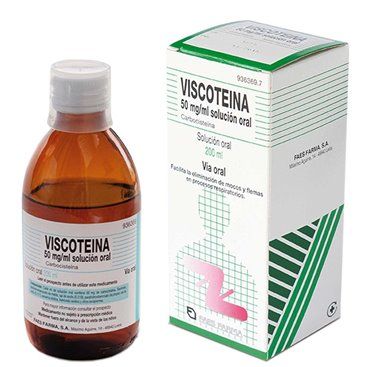Viscoteina 50 Mg/Ml Oral Solution 200 Ml
Viscotein belongs to a group of medicines called mucolytics, and is used to fluidize excessive and/or thick bronchial secretions, facilitating their elimination.
Viscotein belongs to a group of medicines called mucolytics, and is used to fluidize excessive and/or thick bronchial secretions, facilitating their elimination.
Viscotein (50 Mg/Ml Oral Solution 200 Ml)
ACTION AND MECHANISM
- Mucolytic. Carbocisteine is an S-acetylated derivative of the naturally occurring amino acid cysteine. It increases the synthesis of sialomucins by activating sialyl-transferase, thereby restoring the normal glycoprotein composition of bronchial mucosa secretion, and normalizing the viscoelasticity of bronchial mucus. This results in an improvement in expectoration and a cleaning of the bronchus.
PHARMACOKINETICS
- Absorption: rapid oral absorption, with a tmax of 1.5 h.
- Distribution: your Vd is 60 l. It tends to accumulate in the lungs and bronchial mucus, where the maximum concentration is reached after 2 hours.
- Metabolism: several inactive sulfur metabolites have been obtained, such as carboxymethyl-cysteine oxide, carboxymethylthiol-cysteine, thiodiglycolic acid or the S-oxide of this acid.
- Elimination: mainly in urine, in unchanged form (80%) or as metabolites (15%). It appears in small amounts in feces (0.3%) and through the lungs. The t1/2 is 90-120 min.
INDICATIONS
- [BRONCHIAL HYPERVISCOSITY].
* Symptomatic treatment of respiratory and otorhinolaryngological processes that require fluidization of mucus and/or expectoration.
POSOLOGY
- Adults: 15 ml (750 mg)/8 h. Once the patient improves, it can be reduced to 10 ml (500 mg)/8 h.
- Children and adolescents < 18 years:
* Adolescents > 12 years: 15 ml (750 mg)/8 h. Once the patient improves, it can be reduced to 10 ml (500 mg)/8 h.
* Children 6-12 years: 5 ml (250 mg)/8 h.
* Children 2-5 years: 2.5 ml (125 mg)/6-12 h.
* Children < 2 years: contraindicated.
- Elderly: do not require dose readjustment.
Duration of treatment: consult the doctor and/or pharmacist if the symptoms do not improve after 5 days.
Missed dose: Skip the missed dose and administer the next dose at the usual time. Do not double the next dose.
DOSAGE IN RENAL FAILURE
No specific dosage recommendations have been made. It is recommended to use with caution due to the risk of accumulation of carbocysteine.
DOSAGE IN LIVER FAILURE
No specific dosage recommendations have been made. It is recommended to use with caution due to the risk of accumulation of carbocysteine.
RULES FOR CORRECT ADMINISTRATION
It is recommended to drink a glass of water after each dose. Drink plenty of water during treatment.
Administration with food: administer before meals.
CONTRAINDICATIONS
- Hypersensitivity to carbocysteine or any other active substance related to cysteine, as well as allergy to any other component of the medication.
- [PEPTIC ULCERA] active. Risk of aggravation.
- Children < 2 years. Risk of bronchial obstruction.
PRECAUTIONS
- [HYPOTHYROIDISM]. Carbocisteine has given rise to cases of transient hypothyroidism in patients with compromised thyroid function. In case of aggravation of hypothyroidism, the patient should be evaluated.
- Renal failure: There are no specific recommendations. However, up to 80% of the drug is excreted unchanged in the urine.
- Evaluate the clinical situation in patients with asthma or other severe respiratory failure, since the increase in tracheobronchial mucus can increase the symptoms of COPD.
PRECAUTIONS RELATED TO EXCIPIENTS
- This medicine contains sucrose. Patients with hereditary [FRUCTOSE INTOLERANCE], glucose-galactose malabsorption, or sucrase-isomaltase insufficiency should not take this medicine.
- This medication contains sodium salts, which should be taken into account in patients with low-sodium diets.
- This medicine contains sucrose. Its use in oral liquids and pharmaceutical forms that remain in contact with the mouth for some time can harm the teeth.
ADVICE TO THE PATIENT
- Drink plenty of water during treatment.
- Do not use antitussives while using carbocysteine.
- Consult with the doctor and/or pharmacist if the symptoms worsen or do not improve in 5 days, or if fever, headache or sore throat appears.
SPECIAL WARNINGS
- The use of mucolytics and expectorants in children under 2 years of age is contraindicated due to the risk of bronchial obstruction.
INTERACTIONS
- Antitussives. Risk of bronchial obstruction, due to the inhibition of the cough reflex, and the increase in the production and/or fluidization of mucus. Avoid association.
- Anticholinergics (atropine, antihistamines, tricyclic antidepressants, antiparkinsonians, neuroleptics, MAOIs). They could oppose the effect of carbocysteine.
PREGNANCY
Animal Safety : No adverse reactions have been found for reproduction in animals.
Safety in humans : Adequate and well-controlled studies in humans are not available. Its administration is only accepted if there are no safer therapeutic alternatives, and the benefits outweigh the possible risks.
Effects on fertility : No specific studies have been performed on its effects on fertility.
LACTATION
It is unknown if it is excreted in milk, and the consequences it could have for the nursing infant. Is recomended to suspend the lactancy or evy the administration.
CHILDREN
The use of mucolytics in children under 2 years of age has been associated with the appearance of bronchial obstruction, as a consequence of increased production and fluidization of bronchial secretion and insufficient bronchial drainage. Therefore, the use of mucolytics in these children is contraindicated.
In older children, the pharmaceutical form and dose should be adapted to the age of the child ( see Dosage ).
SENIORS
No specific problems have been described in the elderly that require a dose readjustment.
EFFECTS ON DRIVING
Its effects do not seem to be particularly significant, although it must be taken into account that adverse reactions such as vertigo or dizziness have been described.
ADVERSE REACTIONS
Adverse reactions are described according to each frequency interval, being considered very common (>10%), common (1-10%), uncommon (0.1-1%), rare (0.01-0.1%). , very rare (<0.01%) or frequency unknown (cannot be estimated from the available data).
- Digestive: frequent [NAUSEA] and [VOMITING], [DYSPEPSIA], [ABDOMINAL PAIN]; rare [DIGESTIVE BLEEDING]; unknown frequency [GASTRITIS], [GASTRALGIA].
- Neurological/psychological: rare [HEADACHE], [VERTIGO], [DIZZENESS].
- Respiratory: very rare [BRONCHIAL SPASM].
- Dermatological: rare [EXANTEMATIC ERUPTIONS], [PRURITUS]; very rare [ERYTHEMA].
- Allergic: rare [HYPERSENSITIVITY REACTIONS].
- Endocrinological: unknown frequency [HYPOTHYROIDISM].
ADVERSE REACTIONS RELATING TO EXCIPIENTS
- Because it contains methyl parahydroxybenzoate, it can cause [ALLERGY TO PARABENS], possibly delayed.
- Because it contains propyl parahydroxybenzoate, it can cause [ALLERGY TO PARABENS], possibly delayed.
OVERDOSE
Symptoms : potentiation of adverse reactions, especially of the digestive type.
Measures to take :
- Antidote: there is no specific antidote.
- General elimination measures: if ingestion is recent, less than 1 hour, gastric lavage may be necessary.
- Treatment: symptomatic treatment. Ensure ventilation, keeping the bronchi free by means of bronchial aspiration of the mucus.




